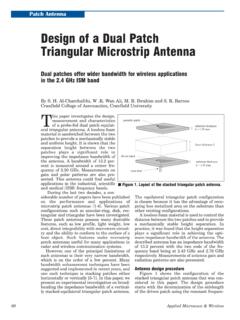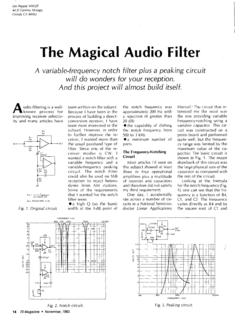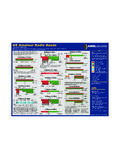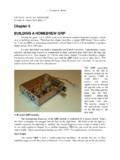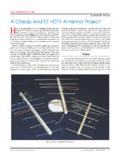Transcription of E.T. Rea Home - N5DUX
1 How Rea ed Home If it were not for an inventive ham, E. T. might still be trying. In this exclusive article, the designer of the little guy's communicator unveils its inner workings. Henry R. Feinberg K2 SSQ 415E 85th Street New York NY 10028 d d CIF," I thought as I re- Tturned from lunch to my office in the exhibit department of Bell Labs. Ly- ing on top of my desk-on top of a pile of exhibit plans-was a telephone message asking me to call Kathleen Kennedy in Hollywood. Now, the public relations department of Bell Labs gets many requests for information, but this one was considerablv more un- usual than most. Ms. Kennedy, who pro- duced with Steven Spielberg, had called Bell Labs earlier that day to find someone who would work at home during the week- end, designing a space com- municator to be used by a stranded alien to contact his space ship.
2 Few other details were given, as a great deal of secrecy surrounded the film. Even the name of the film was a secret. I was told that the alien was called , short for extra-terrestri- al, but the working title giv- en me for the film was de- ceiving; it was called "A Boy's Life." I guess the call was re- ferred to me because of my experience in using house- hold objects to explain sci- ence. My title at Bell Labs at Pictorial drawing of the E. T. communicator. 52 73 Magazine April, 1983 the time was Exhibits and Science Presentations Coor- dinator. Before coming to the Bell system, I worked with Don Herbert, TV's "Mr. Wizard," designing experi- ments using everyday mate- rials to explain scientific principles. At the Labs, I continued my work popular- izing science through films, demonstrations, and exhib- its.
3 Currently, my work at AT&T involves corporate ex- hibitions such as the Bell System's Futurecom at Ep- cot Center in Walt Disney World. Kathleen Kennedy asked me to work by phone with Melissa Mathison, who was writing the E. T. script and who was also associate pro- ducer. I had several long phone calls with Melissa, discussing items found around the house that could be used in a communicator. As an avid ham- radio opera- tor with a limited junk box, I first looked for ho~~sehold objects that could actually transmit a signal. Transmit- ters of various sorts were too ordinary, of course. I was looking for something more exotic, something like a mi- crowave oven that could be converted to send a signal into space ~labsibilit~ was a big fac- tor. While the commcrnica- tor didn't actuallv have to work, I wanted it t'o be plau- sible enough that my ham friends at Bell Labs wouldn't laugh me away FI-om the "ham table" in the cafeteria.
4 I also wanted to avoid a science-fiction look with a lot of blinking lights, coils, and sparks. It was important to me that people seeing the film would not be scared away from the science, and might even understand how a communicator like this might work. Using a microwave oven as a transmitter seemed plausible enough, and I ex- panded on the fanciful de- sign by placing a round hub- cap in the oven to focus the microwave energy out the door and into a waveguide made of flexible aluminized air-conditioning duct. The duct could be rurl out the kitchen window to an anten- na made by inverting a met- al patio umbrella and using it as a parabolic reflector. At this point, before I'm accused of gross ignorance for failing to recognize how the oven would be de-tuned or how inefficient the sys- tem would be, remember that the objective was plau- sibility, not practicality.
5 It was the thought that count- ed, and I was having fun thinking of possibilities such as building a flying spot- scanner using a combina- :ion of mechanical and elec- tronic components-like Christmas tree ornaments and loudspeakers with mir- rors attached. Melissa Math- ison told me that Steven Spielberg liked the micro- wave oven idea but wanted a portable unit to work from a forest clearing. Back to the drawing board. During my years with Mr. Wizard, we put together one Rube Coldberg contraption after another to illustrate scientific principles. Invari- ably, we would use house- hoid materials in unortho- dox ways. Psychologists call this type of creative brain- storming a release from The communicator. [Photo copyright O 1982, Henry R. Feinberg] "functional fixedness.
6 " Briefly stated, it means that you can do more with an old 813 than build a lamp with it. The trick is to analyze the desired result by function, breaking down each section to as simple a scale as possi- ble; then it's easier to build the unit from the ground up in a new way. (Sounds a lot like writing a computer pro- gram, doesn't it?) What Spielberg wanted was a beacon transmitter- something to say "Here I am! Come and get me!" I reasoned that three main parts were needed for a basic beacon: a means of producing a message, a pro- grammer to repeat the mes- sage, and a way of transmit- ting the signal into outer space. Working backward, I knew that a golf umbrella lined with aluminum foil would make a plausible- looking parabolic reflector. And on my last trip to the Dayton Hamvention, I saw coffee cans being used as resonators for receiving MDS TV signals.
7 In fact, a UHF TV tuner purchased there could be extensively modified to act as a multi- plier to select the ump- teenth harmonic of a CB sig- nal from a toy handie-talkie. The resulting microwave sig- nal could then be directed from the coffee-can resona- tor toward the umbrella re- flector through a wave- guide/matching section made from a funnel. Ah. the license of plausibility! To produce the message, I used a Speak and SpellTM learning aid made by Texas Instruments. The unit con- tains a speech synthesizer, a keyboard, a flourescent read- out, and a speaker. de- served his own alphabet, so I rewired the segments of the alphanumeric readout. It took several tries to make the resulting gibberish look like another language. No changes were made in the s~eech circuits since I thought the.
8 Sound-effects people would add their own sound. Actually, they never did, and in the film one doesn't hear any sound at all from the communicator- not even the original "mes- sage" I devised with the help of Debbie, my wife. It was our names repeated over and over The remaining problem was how to program the Speak and Spell to repeat the same message over and over. To begin with, wires were attached to each key- board contact. A set of feel- ers was needed for the other end of the wires. Originally, I used a row of safety pins inserted through the dowel of a wooden coat hanger. But these were a problem to keep straight under pres- sure. Debbie deserves the credit for suggesting bobby pins. Their flat cross-section prevented them from mov- ing sideways. The coat hanger was posi- tioned across a child's rec- ord player.
9 On the turntable, a circular metal saw blade took the place of a record. The surface of the saw blade was coated with several lay- ers of spray paint which served as insulation, pre- venting the bobby pins from contacting the metal blade. The message was pro- grammed on the blade by carefully scratching through the paint. This created a pat- tern of openings similar to those on a punched card through which selected sets of bobby pins could make contact with the blade as it turned. But how to turn the saw blade? Well, since the com- 73 Magazine * April, 1983 54 ICOM-KENWOOD OWNERS!! See the NOVAX in Dayton at the USERS INTERNATIONAL radio CLUB BOOTH 0 - an Information exchange for ICOM & KENWOOD users (Newsletter subscr~pt~ons ava~lable) 1 endorses selected amateur equipment ~ See the NOVAX line of Simplex Auto Connects - Show Specials!
10 1 We're looking forward to seeing you!! 1 Rob Rich Sharon Tony Box 162 - Tudrnan Rd. Westrnoreland, 13490 or Phone 315-829-2785 I (formerly R. W. D. Inc.) municator was to work by it- self in the forest and saw blades have teeth, I decided to use wind power to rotate the blade via a ratchet I mechanism A knife and fork were h~nged together and made to nlvot on the spindle of thk turntable. Each back-and-forth motion of the knife and fork nulled another tooth of thk saw blade around and created another set of contacts. A rubber band returned the knife between pulls. A string tied between the knife and a nearbv tree branch was all that has needed-the rest was a breeze! How were the electronics powered? As Melissa Mathi- son rationalized it, came from an agrarian soci- ety that had learned to tap the forest for electrical pow- er.

